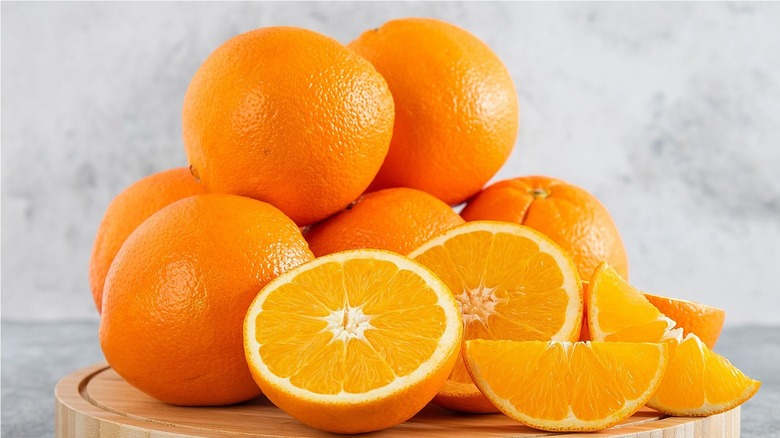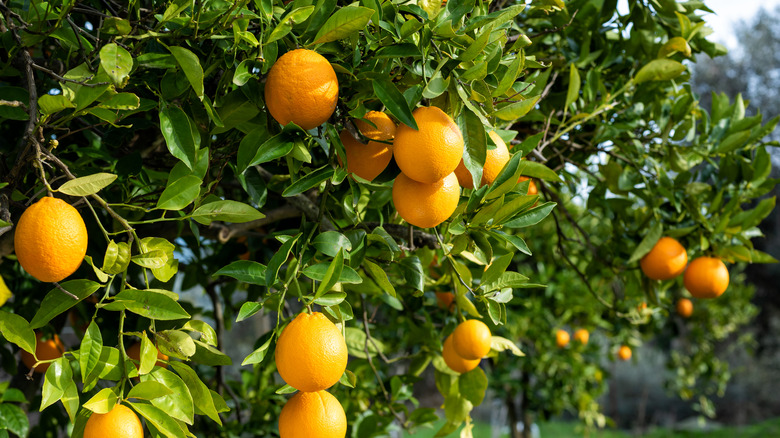World War II's Role In Making Florida A Top Producer Of Oranges
It may be odd to think that anything good comes from war. However, crisis situations like World War II can sometimes be the instigator of advancements in medicine and technology that would never have been possible otherwise. Aircraft, for example, was such an important tactic during the war that investment in this area saw innovations in aviation development that are used today in the passenger planes that take us across the globe, per Simply Flying. Penicillin was discovered in 1928 by Alexander Flemming but very little was done in its progress until WWII forced it into large-scale production, serving some 2.3 million doses that saved the lives of many — and continues to do so today (via The National WWII Museum).
While you may be aware of these big, life-changing innovations, the war changed other more humble things including food. Cookist reports that due to food shortages, governments introduced rationing and prompted people to grow their own fruits and vegetables. They also started to emphasize the importance of nutrition — not only on the home front but for the soldiers who were under duress and vitamin C was an important commodity, especially in preventing diseases such as scurvy. However, the issue then became not only the vast amount of orange juice needed to send over to the troops but also how they would send it as fruit would likely spoil by the time it reached the front. That's where Florida orange juice came into the picture.
Victory Vitamin C
Good nutrition was essential for troops overseas and demand for oranges increased beyond what was readily available, Time reports. The federal government provided funding for growers to plant over 100,000 acres in Florida in the 1940s. The sub-tropical climate, rainfall, and sandy soil in the region provide the best environment for thriving citrus crops. Today, the industry contributes an average of $8.6 million to the state of Florida and employs around 45,000 workers, making up 90% of all oranges produced in America.
However, The Naval Historical Society reports that while crops of oranges started to increase to meet demand, other production issues were encountered. The federal government put its prisoners of war (POWs) to work, building a 65-acre plant to process the juice in Lake Wales, Florida according to The American Homefront Project. The plant was called Citrus World and is still in operation today — though much updated in the last 70 years.
The next issue was how to get the juice to war fronts in Europe without it spoiling. The answer was canned, frozen orange juice. While it existed at this time, the product was undrinkable by the time it reached consumers. Time said that the beverage degraded during shipping. Despite the U.S. Army Quartermaster offering a "lucrative contract" to anyone who could solve this issue, it wasn't until 1945 that USDA scientists developed a workable technique with frozen OJ concentrate.
The future of Florida's orange crops
Once the secret to successfully shipping "Victory Vitamin C" to troops was discovered, the U.S. Army ordered 500,000 pounds of the product to be sent overseas. However, the war ended before the product was ready. As a result, the home front got to enjoy the drink instead. The product was eventually named Minute Maid — meant to imply convenience — and the company renamed itself from Vacuum Foods Corporation to the household name that we know so well today, per Time.
Prior to WWII, California had been the biggest producer of oranges in the US, per WLRN. However, it wasn't long before Florida surpassed the West Coast state to become what it is today. America is currently the fifth-largest orange grower in the world, and until 2021, Florida was the largest producer. However, the AP News reported in January that this year's season might be the lowest yield since 1944-45. Unfortunately, citrus greening bacteria, a disease that's deadly to citrus trees has been damaging crops in the state for the past 25 years. While this may seem disappointing, Hurricane Ian also impacted the orange harvest. It's still too early to determine if Florida's citrus production can recover from both disasters.


